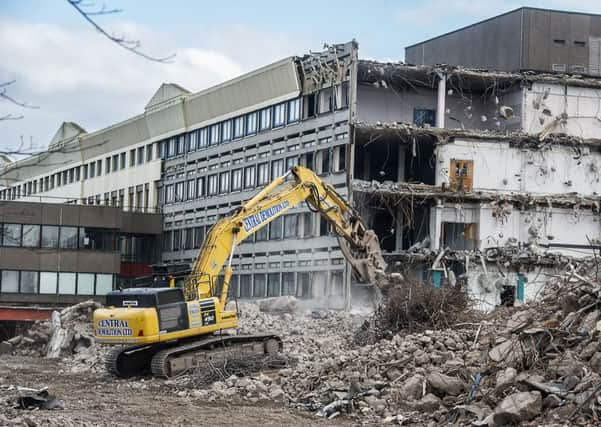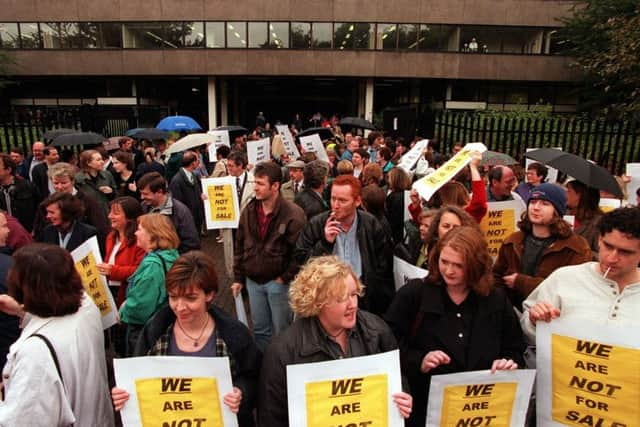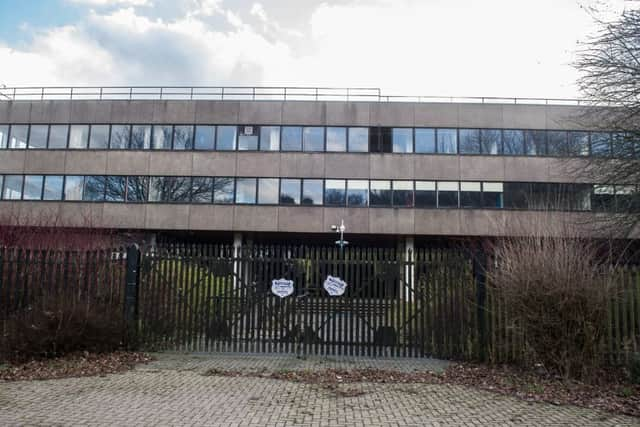A fond farewell as famous Glasgow workplace is demolished


Demolition of the National Savings & Investments Bank (NSB) on Boydstone Road in Cowglen is currently ongoing, with the huge office complex set to be replaced by up to 450 new homes courtesy of builders the Persimmon group.
Cowglen’s last employees moved out in July 2015, transferring to two new sites at Glasgow city centre and East Kilbride.
Advertisement
Hide AdAdvertisement
Hide AdThe bank first opened in 1966 when services were transferred from London to Glasgow. Initially employing just 11 staff, the large office would eventually boast over 6,000 workers at its peak in the Seventies and Eighties.


As a major employer serving Glasgow and the surrounding towns, it wasn’t uncommon for generations of family members to work with one another at the Cowglen bank.
Former employee, Mary McKenna Rankin, who started at Cowglen in 1983 as an Administrative Assistant recalls the office’s unique, communal atmosphere: “A lot of us, myself included came straight from school. There were a lot of families working together there at one point, and you’d be working with your mother, grandmother etc. It was a great family atmosphere in the early days, which gradually disappeared over time.
“People came in from Linwood, Paisley - all over. I came in from East Kilbride, and there was a whole load of us who would get a special bus in together.”
As the number of employees continued to grow, NSB management began to create what Mary describes as “a wee city in the heart of Pollok”: “It was a great place to work and it seemed to have everything right there on site. There used to be a social club right across the road, and we’d all be encouraged to head over to grab a quick drink at lunchtime. The complex had its on Bank of Scotland, a hairdresser’s, a crèche, a couple of shops - one internally and another external. I also remember people selling things on the fly in the locker rooms!


“There were so many different areas to Cowglen, it was massive - like a wee city in the heart of Pollok. Before Silverburn shopping centre was built, there really was no need to go anywhere - it had everything.”
Other facilities at the Cowglen complex included a video library lending tapes and CDs, and a theatre which hosted charity dos. Sports days and Miss NSB competitions were something to look forward to on an annual basis, with each NS&I site taking turns to host the events, and there was also a regular NSB newspaper for staff to keep up-to-date with company goings-on.
Advertisement
Hide AdAdvertisement
Hide AdAnd for company execs, there would be no need to fork out for a posh hotel in the centre of town, the bank had its own digs on site: “We had apartments at the bank for hosting dignitaries and all the company’s top brass when they were visiting from down south”, recalls Mary, “Staff also enjoyed the posh canteen facilities with a great selection of food. I’d never ate so well! There was an early dinner trolley which used to come round and a late one. You had to make sure you were on the early, though, because sometimes the late trolley would have nothing left!”


Another memory which sticks out for Mary is dealing with the thick cloud of cigarette smoke which once filled the office: “Everyone used to smoke at their desks back then... You could cut the air, the smoke was so thick.”
The Cowglen office was also responsible for many a romance: “I met a couple of future partners there as did a lot of people. It was a very sociable place, and, especially in the early days, people tended to stay with the company longer. It meant you built up strong friendships. There was also the punch room which was dominated by lots of girls who all the guys used to fancy!”
The construction of a motorway extension in the 1990s also caused an uproar: “When they built the M77 extension past Pollok, there was a camp of conservationists who set up camp across the road from us. I can remember seeing them being taken away.
Mary climbed up the ladder at Cowglen, ending her time there in 1998 as part of the IT team. Soon after she departed Siemens took over the running of the office: “I left for better prospects just before the Siemens takeover. The people who stayed enjoyed good bonuses at this time, as well as perks such as discounts on Siemens products. But the family atmosphere was all but gone”


For those like Mary who can remember the close-knit community feel at Cowglen National Savings & Investments Bank, the demolition of their iconic workplace will be a hard pill to swallow.
